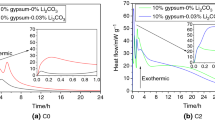Abstract
This article presents the results of a study devoted to determining the effect of sodium tripolyphosphate (STPP) additives on the properties of magnesium chloride composites, in particular, on their resistance to long-term water saturation. Magnesium oxychloride cements (MOC), especially based on dolomites, are highly prone to cracking when exposed to water for a long time. This effect depends on the degree of crystallization of the main active component—magnesium oxide, which is part of their composition. With an improper degree of crystallization, an artificial stone is formed, which individual phases are capable of creating internal stresses leading to destruction during long water saturation. In this paper, we consider the ability of the STPP modifier to stabilize these phases, as well as its effect on some physical and mechanical properties of chlorine magnesia composites. During the research, methods of mathematical planning of the experiment, standard methods for studying strength characteristics and water absorption by weight were used. It has been shown that the introduction of STPP additive reduces the strength of composites, but contributes to an increase in their resistance to cracking during prolonged water saturation.
Access this chapter
Tax calculation will be finalised at checkout
Purchases are for personal use only
Similar content being viewed by others
References
Vinnichenko VI, Ryazanov AN (2015) Resurso-i energosberegayushchie vyazhushchie iz othodov dolomita (Resource and energy saving binders from dolomite waste) In: Energy and resource saving environmentally friendly chemical-technological processes of environmental protection. Belgorod, pp 22–32
Pyzhov EV (2020) Ocenka vozmozhnosti ispol'zovaniya othodov gornodobyvayushchej promyshlennosti v proizvodstve stroitelnyh izdelij (Evaluation of the possibility of using mining waste in the production of building products) In: International scientific and technical conference of young scientists, pp 3185–3191
Miryuk OA (2014) Perspektivy ispolzovaniya othodov v tekhnologii magnezialnyh stroitelnyh materialov (Prospects for the use of waste in the technology of magnesian building materials). Sci World 11:41–44
Lebedeva NS, Nedayvodin EG, Sukhikh SD (2017) K voprosu povysheniya ognestojkosti stroitelnyh materialov na osnove magnezialnogo vyazhushchego (On the issue of increasing the fire resistance of building materials based on magnesian binder). Modern Probl Civ Protect 24:65–68
Nosov AV et al (2013) Vysokoprochnoe dolomitovoe vyazhushchee (High-strength dolomite binder). Bull SUSU: Series Arche Const 13:30–37
Uryasheva NN, Kovaleva OI, Kovalev NV (2018) Research of the magnesia cement stability to the impact of corrosive biological environments In: IOP conference series: materials science and engineering, IOP Publishing, vol 451, p 012035
Lauermannová AM et al (2021) High-performance magnesium oxychloride composites with silica sand and diatomite. J Market Res 11:957–969
Khalil A, Wang X, Celik K (2020) 3D printable magnesium oxide concrete: towards sustainable modern architecture. Addit Manuf 33:101145
Nosov AV, Chernykh TN, Kramar LY (2014) Dobavki-intensifikatory obzhiga dolomita (Additives-intensifiers for dolomite firing). Sci SUSU 1:998–1002
Tyukavkina VV, Gurevich BI (2014) Vliyanie rezhimov obzhiga dolomita na svojstva magnezialnogo vyazhushchego (Influence of dolomite roasting regimes on the properties of magnesian binder). Dry Constr Mix 1:33–36
Khuziakhmetov RK (2013) Tekhnologiya magnezialnyh vyazhushchih iz dolomitovogo poroshka i ocenka kachestva produktov obzhiga (Technology of magnesian binders from dolomite powder and assessment of the quality of roasting products). Bull Kazan Tech Un 7:101–107
Kramar LY (2007) Teoreticheskie osnovy i tekhnologiya magnezialnyh vyazhushchih (Theoretical foundations and technology of magnesian binders and materials). South Ural State University, Chelyabinsk
Kramar LY, Nuzhdin SV, Trofimov BY (2007) Compositions based on magnesian binder, not prone to cracking during operation. Bull SUSU: Series Arche Const 14:15–17
Yelenova AA, Krivoborodov YR (2016) Vliyanie gidrodinamicheski aktivirovannoj dobavki kristallogidrata na gidrataciyu i tverdenie cementnogo kamnya (Influence of hydrodynamically activated additive of crystalline hydrate on hydration and hardening of cement stone). Adv Chem Chem Technol 30:36–38
Krivoborodov YR, Boyko AA (2011) Vliyanie mineralnyh dobavok na gidrataciyu glinozemistogo cementa (Influence of mineral additives on the hydration of aluminous cement). Tech Technol Silic 18:12–15
Guvalov AA, Kabus AV, Usherov-Marshak AV (2013) Vliyanie organomineralnoj dobavki na rannyuyu gidrataciyu cementa (Influence of organomineral additives on the early hydration of cement). Build Mater 9:94–95
Ba H, Guan H (2009) Influence of MgO/MgCl2 molar ratio on phase stability of magnesium oxychloride cement. J Wuhan Univ Technol-Mater Sci Ed 24:476–481
Averina GF, Koshelev VA, Kramar LY (2019) Combined roasting of raw materials modified by additives-intensifiers in form of low humidity sludge. In: IOP conference series: materials science and engineering, IOP Publishing, vol 687, p 022038
Matcovic B et al (1977) The mechanism of the hydration of magnium oxide. J Am Ceram Soc 60:504–507
Rogic V, Matkovic B (1972) Phases in magnesium oxychloride cement (in Serbo-Croat). Cement (Zagreb) 16:61–69
Author information
Authors and Affiliations
Corresponding author
Editor information
Editors and Affiliations
Rights and permissions
Copyright information
© 2023 The Author(s), under exclusive license to Springer Nature Switzerland AG
About this paper
Cite this paper
Averina, G., Koshelev, V., Kramar, L. (2023). Increasing the Resistance of Chloromagnesian Composites to Cracking Under Prolonged Water Saturation. In: Radionov, A.A., Ulrikh, D.V., Timofeeva, S.S., Alekhin, V.N., Gasiyarov, V.R. (eds) Proceedings of the 6th International Conference on Construction, Architecture and Technosphere Safety. ICCATS 2022. Lecture Notes in Civil Engineering, vol 308. Springer, Cham. https://doi.org/10.1007/978-3-031-21120-1_17
Download citation
DOI: https://doi.org/10.1007/978-3-031-21120-1_17
Published:
Publisher Name: Springer, Cham
Print ISBN: 978-3-031-21119-5
Online ISBN: 978-3-031-21120-1
eBook Packages: EngineeringEngineering (R0)




